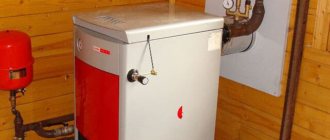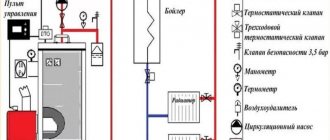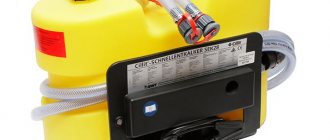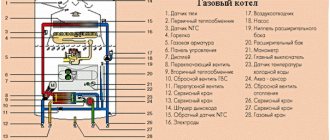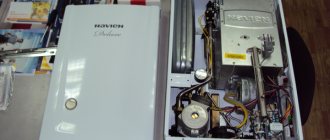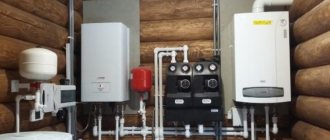The demand for installation of a parapet gas boiler is increasing every day, because most craftsmen prefer this type of modern equipment.
The compact dimensions of the boiler make it an ideal solution for small apartments and private houses, as well as industrial premises where it is simply not possible to install a smoke exhaust system.
The parapet gas boiler has a more advanced design, which significantly facilitates the process of installation and preparatory work.
The system has a closed combustion chamber and its own chimney, thanks to which the boiler no longer needs to be equipped with a combustion product removal system. In this regard, they are also called “flueless boilers”.
The air that supports gas combustion enters the boiler from the street, and the operation of the equipment itself does not depend on electricity.
The history of the creation of a parapet gas boiler
The floor-mounted turbocharged boiler has a closed combustion chamber, therefore it is safe and does not require a separate room.
The product was created in the early nineties of the last century, when mass private construction began and people abandoned central heating. The universal stoves used at that time could operate on any fuel, but they had an open-type burner installed. Since domestic enterprises were closing en masse, and foreign products were unavailable, it was decided to develop and put into production a boiler of our own production that meets all power and safety requirements.
The work was carried out in Ukraine and Luch Russia. In 1996, the first two-circuit samples went on sale, with a compact design, a power of 10 kW, an efficiency of 0.92 and a closed combustion chamber. These boilers became the prototypes of units that are still manufactured today.
Boiler structure
The heating device is small in size, which makes it possible to install it in the kitchen, bathroom or basement level. The presence of convection openings in the body allows the unit to be used as an oven, which makes it possible to avoid installing piping and batteries indoors.
The structure of the products is quite simple:
- durable body covered with heat-resistant enamel;
- closed combustion chamber;
- gas-burner;
- wick;
- heat exchangers (coils made of copper or brass);
- chimney with wind protection.
The product includes automatic control and monitoring devices. These include a thermocouple, an air draft sensor and a thermometer.
Main differences and characteristics
Parapet boilers can have 1 or 2 circuits - for heating and hot water.
Various models are made in floor and wall-mounted, left-hand and right-hand versions. Depending on the purpose, they are equipped with one circuit - only for heating or two - to additionally heat water for domestic purposes. Depending on the level of control, devices can be automatic or manual. For automation to work, electricity is required. If it disappears, the boiler turns off. Manually controlled products are practically independent of external conditions and can even be operated from a gas cylinder. The burner is turned on and off by a thermocouple and a constantly burning wick.
Model overview
If you choose the right manufacturer and model of the boiler, it will be able to effectively heat your home even without the “help” of additional equipment.
Thus, Danko gas boilers have a power of 7 to 15 kilowatts, so they are quite capable of handling a room with an area of up to 140 square meters. All devices from this manufacturer have an automatic gas supply system, micro-torch burners and piezo ignition. The walls of the heat exchanger are 3 millimeters thick.
It is characteristic that the design of this exchanger has been updated, and the right-left connection is ignored in principle. This makes installation easier. The connection in this case is two-way, which significantly saves work space. There is also a special panel that allows you to adjust the operation of the device and visually monitor it.
Video parapet boiler – Model “Danko 7U”
ROSS is one of the largest Russian manufacturers of gas equipment. Boilers from it are known to ordinary users as AOGV and have a power of up to 100 kilowatts.
Parapet boiler Aton Compact
The boilers of the Aton series are no less popular, since considerable funds have been invested in this company in recent years. The boilers are produced using modern equipment, thanks to which excellent external performance of the products is combined with high quality.
Gas parapet boiler Zhitomir
There are also Zhitomir gas boilers, which are perfect for heating a multi-storey building. The fuel combustion chamber in them is absolutely sealed and equipped with automatic process control, a temperature control device, piezo ignition and a built-in gearbox. Each of the boilers has pipes for connection to the heating system on both sides.
The manufacturer guarantees that all products are absolutely safe to use, since they are tested seven times for failure-free operation in emergency conditions. If we talk about efficiency, then it can reach 90 percent.
Video - Advantages of Zhitomir models
Attention! The cost of parapet boilers ranges from 11,250-25,000 rubles, although there are more expensive models. It all depends on the technical parameters and the manufacturer
Advantages and disadvantages
The main advantages of parapet boilers:
- high performance;
- closed combustion chamber ensuring complete safety;
- compactness;
- functionality;
- versatility;
- ease of use and maintenance.
The disadvantages include the need to drill a hole in the wall for the pipe, which negatively affects the supporting structures. If installing a gas boiler in a private house is not a problem, then equipping a city apartment with it is almost impossible, due to the current moratorium on such events. We should not forget about the high cost of equipment and installation work.
How are they arranged?
The parapet boiler has a closed combustion chamber. It does not contact the room. The equipment does not emit combustion products into the atmosphere, which is very important for small areas with poor ventilation. Therefore, these devices do not require traditional chimneys. The side two-pipe design is sufficient for operation. The main task of these pipes is the intake of air and the removal of exhaust gases. Due to the presence of a hole in the unit body, additional radiators are not needed. If you correctly perform all the calculations and select the device, then one unit will be enough for a complete heating system.
READ How to install hdri card in 3d max corona
Installation of parapet boilers is carried out according to the principle of convectors. Due to the pipes, the system is connected to the gas main (and water supply in the case of double-circuit boilers). Next, the unit is mounted on the wall using brackets. The chimney for the boiler is of the coaxial type. It has a small diameter. The reader can see what a coaxial type chimney looks like in the photo below.
Criteria for choosing a parapet gas boiler
Since a gas boiler is purchased for decades, its choice must be taken as responsibly as possible.
For single-circuit boilers it is necessary to install a hot water boiler
When purchasing, you should pay attention to the following criteria:
- Heat exchanger steel thickness. It should not be less than 3 mm, preferably made of non-ferrous metal or stainless steel.
- Product design and effectiveness. To save money, it is better to take dual-circuit devices with an efficiency of 0.92 and higher.
- Dimensions and dimensions. If the space of the room allows, it is advisable to choose a floor-standing option. This type of boiler is more reliable and unpretentious.
- Location of connectors for connection. Depending on the installation location, a type of product with side or rear connection is selected.
- Power. You should purchase a unit at the rate of 1 kW per 10 m² of total area of the house with a reserve of 15% for extremely cold periods.
- Chimney material. The pipe must be made of thick stainless steel, resistant to high temperatures and the formation of soot inside the channel.
- Ease of installation. The cost, duration and labor intensity of the installation of a heating system depends on this.
- Functionality. A single-circuit boiler is smaller and cheaper, but does not solve the DHW problem.
You can get information about which parapet boiler is best to choose for your home in a specialized store that sells certified products.
Preparation for installation
Figure 4. Installation diagram of a parapet boiler: 1 - air duct pipe;
2 — air duct section; 3 - boiler; 4 - seal; 5 — M6 bolt; 6 — clamp; 8 - chimney pipe; 10 — M8 nut; 11 — washer 8; 12 - chimney protection; 13 - eye; 14 — M10 pin; 15 — M10 nut; 16 - washer 10. The very first thing you should start preparing for installation is to read the detailed instructions for installing the device and purchase everything that is necessary to install the boiler and connect it to the heating system: fittings, fittings, fasteners, etc. P.
The next stage of preparation is the selection of tools. To make a hole in a stone wall, you will need at least a hammer drill, or better yet, a hammer drill with a diamond bit that matches the diameter of the air duct pipe (for Aton boilers, the air duct diameter is 240 or 270 mm). If there is no crown, you can get by with a small-diameter drill, the length of which is sufficient to pass through the wall. If you work without a crown, then you will need a spatula, and if you have to work high, where you cannot get to it from the street, then you will need a spatula as long as the thickness of the wall. You will need drills for stone with a diameter corresponding to the fastening elements of the boiler being installed.
You will also need keys (in particular, an adjustable wrench) and screwdrivers in accordance with the fasteners supplied to the boiler and connections to the pipelines.
To remove the coating from the wall, you will need a knife, a spatula, a sponge and a basin if the wall is covered with wallpaper, or another appropriate tool.
The measuring tool you will need is a level and a ruler, most likely you will need a square. You will, of course, need a pencil or marker for marking.
Personal protective equipment: glasses, mask, vibration-proof gloves, possibly knee pads.
The principle of operation of a parapet gas boiler
Layout diagram of the main components of a parapet boiler.
The operating principle of an autonomous boiler is quite simple:
- The wick ignites the burner, which heats the heat exchanger.
- Water moves along the circuit by natural current or under the influence of a pump.
- After heating the working fluid to the set temperature, the thermocouple closes the gas valve and combustion stops.
- When the coolant cools down to the set value, the valve opens and the constantly working wick ignites the gas.
A coaxial chimney is connected to the boiler. It is a structure of two pipes. The internal one removes smoke, and the external one supplies fresh air into the combustion chamber.
Possible problems
One of the problems is icing of the coaxial pipe outside the house during severe frosts. Some owners try to clean off ice, making a mistake: they can damage the pipe, and then they will have to replace it. The correct solution would be to light the boiler and fire it at minimum heat, then gradually increase the flame power. In this case, the pipe will warm up evenly and the ice will melt.
Frozen chimney
You can prevent the heat exchanger from clogging with dirt and debris by installing a filter and periodically changing the main liners that accumulate dirt.
Sometimes strong gusts of wind can penetrate the chimney, causing the fire to go out. The fire also goes out due to a lack of gas, so it is urgent to look for the cause, which may be a leak.
Periodic maintenance is required, as the sensors gradually fail and parts wear out.
DIY boiler installation
A protective cap is installed on the chimney to prevent the wind from blowing smoke back in.
Installation of the boiler must be carried out by gas industry specialists. The property owner can prepare a base or a place on the wall for it, drill a hole for the chimney and make connections for heating and hot water supply. Fixing the device and connecting communications is carried out by a specialist. Exceptions are cases when the boiler is connected to a gas cylinder.
To prevent the wind from blowing into the boiler, it is necessary to make a protective cap at the end of the chimney at the installation stage, which will dampen turbulence and strong air currents. Periodically, the inner pipe must be cleaned of soot, since internal deposits reduce draft.

